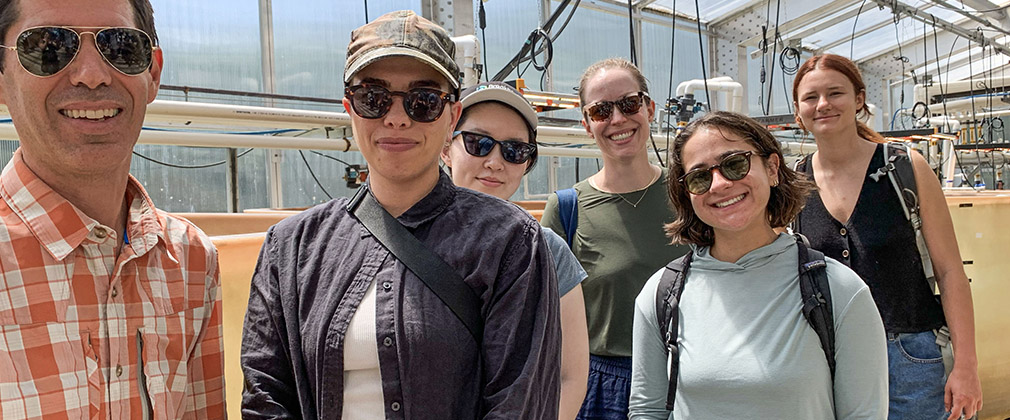Journalism Fellows Dive into Maryland’s Chesapeake Bay
As temperatures approached 100 degrees Fahrenheit on the Eastern Shore, 12 journalists spent the day learning the ins and outs of sustainable production of two of the region’s most important aquatic foods—crabs and oysters. The trip was part of an in-person event that brought together the second annual cohort of the Johns Hopkins Center for a Livable Future’s Food Systems and Public Health Fellowship for Journalists.
The fellows were accompanied by the Center’s senior research associate and independent journalist Tom Philpott, who is a primary steward of the fellowship program, as well as the Center’s Dave Love, a research professor in Environmental Health and Engineering, and Liz Nussbaumer, who directs CLF’s Aquatic Food Systems project. Tiffani DeFreitas, who manages the fellowship program, organized the expedition and accompanied the group.
For the first stop of the day, the fellows visited the Chesapeake Bay Maritime Museum in St. Michael’s, Maryland, where they learned about the history of Native Americans in the region and the geography of the Bay. They also learned about how water pollution, overfishing, loss of habitat, and invasive species have challenged—and continue to challenge—the crab population. The visit concluded with a focus on labor, taking in photos and quotes from those who have picked and processed crabs over the years, and addressing the role of immigrant labor, many working on H-2B visas, today in the crab processing lines.
“Crabs and crab-picking labor are a crucial part of Baltimore’s and the broader Chesapeake region’s history, culture, economy, and identity,” Philpott said. “We learned that they’re under severe pressure from factory farm pollution and invasive species—I could see the story ideas percolating in the eyes of the fellows.”
He adds that he had circulated among the fellows a recent report from the Centro de Los Derechos Del Migrante on working conditions in Maryland’s crab-processing houses.
For the second half of the day, the cohort toured the Horn Point Oyster Hatchery in Cambridge, Maryland. Oysters are a keystone species for the Chesapeake Bay, meaning they provide a support system for many other species in the bay. In the early 1600s, when Captain John Smith from England, “discovered” the Chesapeake Bay, rivers, and coastlines, he described oysters “lying thick as stones.” (Smith is known for his controversial involvement at the Jamestown colony, the first permanent English settlement on the continent, during its early years.) In the late 1800s, about 15 million bushels of oysters were pulled from Maryland waters each year.
Today, the oyster industry in Maryland is at a historical low; recent harvests are about a half a million bushels. The Horn Point Oyster Hatchery engages in oyster restoration in the Bay, and it’s supported with state funds, federal funds from agencies such as NOAA and the Army Corps of Engineers, and NGO funding. The hatchery produces oyster seed (spat), which attaches to oyster shells, and then dumps the spat-on-shell onto man-made reefs. The hatchery also produces oyster seed and sells them to commercial oyster growers for profit.
The Center’s Dave Love, an expert on aquatic foods, notes that the hatchery is a state-funded project to build the oyster population, but that because oysters are a keystone species, the benefits extend beyond the oyster industry.
“Today more than ever, people need to see examples of how much state governments are benefitting citizens’ lives, because oysters are a resource for everybody,” he says. “This project contributes to the oyster industry as well as the fishing and crabbing industry by restoring habitats for all the critters that commercial and recreational fisherman want to catch.”
The trip to St. Michael’s and Cambridge is just one component of the yearlong journalism fellowship program offered by the Johns Hopkins Center for a Livable Future. The fellowship program, which launched in 2024, is designed to help early-to-mid career journalists navigate the complexity of issues at the intersection of public health and food systems, with a special focus on issues associated with food animal production.
For this year’s cohort, the multi-day immersion experience portion of the program included presentations by and meetings with Johns Hopkins University faculty experts, public health researchers, food policy analysts, community health advocates, and journalists with extensive experience on the food systems beat. (The schedule of presenters, which includes researchers and editors, can be found here.)
The 2024 cohort was composed of seven journalists, and they visited Ebenezer Haitian Seventh-Day Adventist Church in Seaford, Delaware, where they heard first-hand stories from workers in slaughter and processing facilities.
